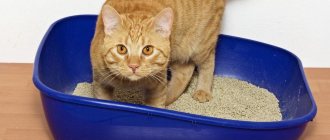4595Administration
Every cat needs water treatments from time to time. For this reason, it is important to know how to teach a kitten to bathe. If a four-legged pet gets used to water from early childhood, caring for it will become much easier and more convenient. Often, the owner’s mistakes lead to the kitten experiencing fear before bathing, which is reinforced and persists for life. As an adult, such a pet will always be afraid to swim. Teaching a cat to bathe is more difficult than teaching a kitten. Only special cats naturally love water and tend to bathe themselves, so attention should be paid to training them for such a procedure.
Causes of fear
Fear and aversion to water is a natural cat reaction.
Your pet can and should be bathed. The cause of fear is caused by many factors. This may be an unusual environment, too bright light, noise and shouting of people.
Situation
In the bathroom, the animal's movements are constrained, sounds seem sharp, and the sound of water is frightening. Often the owner shouts at the cat if it behaves too aggressively.
The animal does not like that in the bathroom it cannot gain stability, clinging to its claws, while being forcibly held down.
Reaction to shower and hot water
Water flows out of the shower spray noisily and in large streams, which greatly frightens your pet. The animal perceives the hissing pressure of water as a living aggressive creature.
Fluid temperature is not always adjusted (too cold or too hot). When swimming, these factors should be taken into account first.
Stage 2: teaching the cat to bathe in the bath
Rita filmed the second video, where cats receive treats already in a filled bath, 16 days later. To begin with, you can put the same basin in the bathtub, then gradually remove it, but perhaps the cats will immediately agree to step into the bathtub. Don't forget to place a rug or a regular rag on the bottom. Also, the animal should have a smooth, rather than abrupt, entry into the water.
Rita operates according to the same scheme - the “yummy” is given only in water and is accompanied by splashes and turns.
If your goal is to teach your cat to bathe in water as quickly as possible, you can stop at this stage, just strengthen it, gradually adding washing elements. But you can go further, as the author of the video.
Tips for the owner: how to wash a cat
To prevent your cat from experiencing stress during bathing, it should be accustomed to the procedure from an early age. Kittens begin to be washed after the complete replacement of milk teeth. At first, they simply dip their paws in water.
How to bathe an adult animal:
- Remove foreign objects from the bathroom, especially those that rattle a lot (buckets, basins, bowls).
- All windows are closed to avoid drafts.
In the bathroom, a towel and pet shampoo are placed at arm's length so that they can be quickly grabbed.- The water temperature and pressure in the mixer are adjusted in advance so as not to frighten the animal during the bathing process.
- The door to the bathroom is closed, sudden sounds and movements are avoided.
- Select a suitable water temperature in the mixer at + 35 ° C, fill the bath one third with liquid.
- The cat is taken by the withers and placed in a container. Wash the paws and body with water (it is important that the liquid does not get into the eyes, nose, ears).
- A small amount of shampoo is squeezed into the palm of your hand, rubbed, applied to the pet’s fur, and foamed. While bathing, the cat is calmed down, talked to calmly and affectionately.
- The foam is washed off with a shower hose, the pressure is set to low so as not to frighten the pet.
If necessary, the entire procedure is repeated twice.
The shampoo is washed off thoroughly: cats lick themselves, and the remains of the detergent can get on the tongue and into the esophagus, harming their health.
Then the pet is dried with a towel; you can dry it with a hairdryer if the cat is not afraid of its noise.
How to bathe a cat for the first time?
So, we found out that your cat should first become acquainted with water and shampoo at a young age. It should be remembered that a kitten has a vulnerable child’s psyche. The owner’s task is not to instill in the baby a persistent aversion to water and the entire procedure as a whole. To do this, you must follow some rules. The baby’s attitude towards this procedure in the future depends on the very first bath.
A kitten should be accustomed to water from three months. Usually, before this age, his mother washes him out. However, there are exceptions to every rule. If a kitten is very dirty at the age of one month, then it can and should be bathed. You should not carry out the first procedure in the bathroom. A basin is more suitable for this, as it doesn’t look as intimidating to a baby as a huge white bathtub, and it will also be easier to keep him in the water.
You need to pour a little water so that it just reaches the kitten’s tummy. While bathing, talk to your baby in a quiet voice and call him by name. Do not wet the kitten's head from the shower; clean the fur on it with a sponge. Use shampoo for kittens, choosing it based on your pet's coat type. If you can’t purchase it, use any children’s one.
Preparation for water procedures
Prepare for washing the cat in advance.
Everything necessary for the procedure is laid out nearby, and unnecessary items are removed. Protect your pet's ears with large balls of cotton wool. They should be large enough to cover the ear canal, and after the procedure it will not be difficult to remove them.
To clean the fur, use special shampoos for animals. Detergents for humans are not suitable for them: such products have a different acidity level (PH) and cause irritation on the skin of pets.
Nail trimming
To protect yourself and the animal if it scratches, the cat’s claws are cut before taking a bath. Frightened cats often try to get out of the bathtub by climbing up their owner's arms.
An animal without claws will cause fewer injuries.
Use of special devices
Pet stores sell mesh bags for bathing cats.
The animal is placed in this bag, the headband is fastened around the pet's neck. The device will help pacify your pet: he will not scratch or try to get out of the water.
Large mesh cells do not prevent the penetration of water and detergents into the wool, and bathing will take place without problems. The owner will have both hands free, he can easily soap the pet and rinse off the detergent.
Bath equipment
It is important to prepare the bathroom before bathing your cat at home. A soft mat is placed at the bottom of the bath, which fits tightly to the surface.
Place 2 buckets with a volume of up to 15 liters nearby, wide but shallow, and fill them with warm water. Metal containers create a lot of noise, so it is better to choose plastic. Several caps of concentrated pet detergent are dissolved in one.
It is better not to use basins: they take up a lot of space.
Detergents are placed on the side of the bathroom so that they are easy to reach.
The shower is turned on at the lowest power so that the noise of the water does not frighten the pet. Place old towels or clean sheets nearby, which absorb liquid well after bathing.
Assistant
If a cat bites or runs away from the bath, and there is no special device to restrain it, the help of another family member is needed.
It is easier to bathe a cat without consequences together: the assistant will hold the pet, and the owner will wash the animal without difficulty.
LiveInternetLiveInternet
Quote from the message INTERESTING_BLOG_LesyakaRu
Read in full In your quotation book or community!
How to train a cat to bathe in the bath!
Everyone knows that cats really don’t like bathing and avoid this procedure in every possible way, probably believing that they lick themselves well enough. But after amazing walks there is sometimes an urgent need to wash it. How often should you wash your cat and what can you do to teach it to bathe?
It is often not recommended to bathe cats, since their natural fatty lubricant is washed out by shampoos, while the skin no longer shines so gracefully, the skin dries out, and becomes susceptible to various diseases and infections. But before an exhibition or show you have to bathe her, and also if she comes in dirty from the street. Skin diseases also require cleanliness.
Let's look at how to teach a cat to bathe . In general, cats do not like to bathe, but only some breeds agree to categorically accept such an exotic procedure for themselves. Despite the fact that cats are difficult to train, if you teach them to bathe from a young age, they will gradually get used to it. And, naturally, very small, stupid kittens are relatively calm about water, but as soon as they grow up a little, their rage knows no bounds. If you interest the kitten, but do not force it, then resistance will be minimal.
First, you need to pour just a little water and wait until the cat climbs in to inquire what is there in the basin? The water should be warm and pleasant, but without violence. And let him only wet his paws. You can also take the kitten in your arms and a small bowl, put one paw there, then the other. The next day, wet all paws. It’s good to put your cat’s favorite toy in the basin. This will also be an incentive to be curious and play.
We looked at how to gradually accustom a cat to water. You can let your cat watch you bathe yourself, showing that it is not at all dangerous. Perhaps your pet will be interested. But still, cats are cats, and if you can’t train them, then there should be no violence under any circumstances. It is difficult to convince a cat, and if she is stubborn, then it is already impossible to change her.
It should be noted that there are special shampoos for cats. They are the ones who best create the acid-base balance and cause the least harm to the skin.
After you teach the kitten to wash , the bathing process itself should be as follows. You put the cat in a basin filled with warm water, the temperature of the cat's body, then take a mug and slowly water it, wetting the skin, and be sure to talk in a gentle voice. Then pour a little shampoo onto your hand and rub it. Then, while continuing to talk, pour clean water over it. Wrap it in a soft cloth and, stroking it, dry your pet. All movements should be calm and pleasant for the cat. And then she will absolutely calmly endure all your actions.
Algorithm for bathing a pet
All actions are performed without haste:
- The animal is picked up, stroked, calmed, and taken to the bathroom. There, the hind legs are fixed with the right hand, holding the animal under the abdomen. With your right hand, grab the front paws, picking up the cat under the ribs.
As soon as the animal is securely fixed, it is carefully immersed in a basin of water, the hind legs are released so that the pet rests them on the bottom of the container.- The front paws are held with the left hand, and the cat is washed with the right. The animal must be immersed in water up to its neck.
- The soap solution is applied to the entire coat (except the head) and the integument is washed with light massaging movements. Areas where vegetation is dense are especially good for cleaning.
- It is not recommended for an overly emotional or fearful pet to wash its hair. This part of the body always remains clean. The muzzle is wiped with a damp towel.
- As soon as bathing in a bucket of soapy water is completed, the cat is transferred to a container with clean liquid. The animal's fur is thoroughly washed to remove any remaining foam.
Water from the shower will help to completely clean the cat of soap.
You can empty the first bucket of dirty water, rinse it, and fill it with clean water. Then the animal is once again transplanted into the container, and its fur is washed well.
After bathing, it is important to thoroughly dry your pet's coat with a clean cloth or hairdryer that absorbs moisture.
The first option is preferable: the noise of the unit is additional stress for the cat.
The owner makes sure that there are no drafts in the house during drying: a wet pet can easily catch a cold. Kittens and older animals with weakened immune systems are especially protected.
A mustachioed pet that has passed all the tests with dignity is given a treat to relieve stress after contact with water.
What should you not do while swimming?
As you can imagine, bathing a cat, a procedure that takes only a few minutes, is quite difficult for both the animal and its owner. Therefore, it is necessary to minimize possible irritants:
- Do not open the tap at full capacity.
- The shower should not be turned on at full power.
- Do not use dog shampoo or dishwashing detergent to wash your pets.
- There is no need to pour shampoo from the bottle directly onto the coat, especially dry hair.
- It is strictly forbidden to stuff the animal's ears with cotton - it can cause serious irritation.
How to teach a cat to bathe
Each owner has his own secrets and approaches to his beloved pet. All of them can be combined into a list of simple recommendations that will reduce the innate fear of water in cats.
Advice from experienced breeders:
It is worth teaching your cat to take water treatments from an early age. From the age of 2 months, the kitten can be placed in a small basin and its paws can be gently washed. Growing up, a seasoned pet will not be afraid of water.- A few days before bathing, an adult animal is placed in an empty basin, having first filled it not with water, but with its favorite toys. At the same time, the animal is given a treat or catnip: the cat will not associate the bathroom and basin with danger.
- As soon as the animal gets used to the empty container, fill it a few centimeters with warm water and put toys in it. The cat is lured with interesting objects or treats, and invited to climb into the basin.
- If your pet is too nervous when taking water procedures, it is better not to keep him in the bathroom for a long time. The animal is lightly rinsed, and bathing is postponed to the next time. The procedure is repeated regularly, do not forget about it.
The pet is combed before washing - this makes washing the fur easier and faster. This removes tangles and dirt, and makes the bathing process easier.
If the cat, after all the tricks, is not used to swimming calmly, contact a groomer. A professional will be able to wash the animal quickly and without consequences, making the task easier for the owner.
How to bathe an adult cat?
If you have not taught your pet to bathe from a young age, then this procedure becomes much more complicated. However, do not think that your attempt is doomed to failure. Below we will present you with tips and recommendations from experienced owners and veterinarians who will certainly answer the question of how to bathe a cat without scratching it.
To bathe an adult animal, use dry or liquid shampoos for cats; in rare cases, it is allowed to use shampoo for people, as well as baby soap.
Minimizing stress when bathing
In order not to traumatize the cat’s psyche too much, the owner should remember the set of rules “Cats on the Water”, ignoring which will turn bathing into a fierce struggle, and the bathroom into a battlefield.
So, for security reasons, it is strongly not recommended:
- Lower the cat into a bathtub or container (basin) already filled with water. Sensing the approach of a large volume of liquid, the animal will turn on its protective instinct and do everything to escape and avoid drowning.
- Putting a choke collar on a cat or tying it with a leash in order to forcefully achieve obedience. Fetters will only increase fear, cause pain and even more intensify the desire to leave the terrible place.
- Water an untrained cat with water from a flexible hose. Murki instinctively avoid water jets falling on themselves, and therefore always hide from the rain. Excessive dousing in the bathroom will also not bring them pleasure.
- Use too cold or too hot water. The skin of cats is very sensitive, so the temperature of the bathing water should be pleasant and not cause discomfort. Usually the water is heated to +38.5-39°C, but on a hot day it can be a little cooler.
- Bathe your cat in low light. It has been proven that in bright light the animal becomes more submissive and is more likely to agree to water “execution”.
Why do kittens wash?
In addition to the question of whether it is possible to bathe a kitten, owners often wonder whether it is necessary to do so. To understand the importance of this procedure, you need to know the reasons why you should bathe an animal:
- First of all, we are talking about appearance. If the kitten is very dirty, it is advisable to wash it to clean the fur. Water treatments help give it shine and make it much softer. Also, after bathing, the original appearance of the coat returns. Water with shampoo washes away dead hairs, which without water treatments would scatter throughout the apartment or house.
- During shedding, a large amount of hair enters the cat's stomach, which disrupts the digestion process. Frequent bathing will help avoid problems associated with the animal's gastrointestinal tract.
- Fight against parasites. You can find special flea shampoos in pet stores and pharmacies. They have a mild effect and effectively help kittens get rid of parasites.
Pets that do not go outside for walks can be bathed once a month. The owner does not need to perform this procedure more often, since the pet independently maintains hygiene by licking the fur.
At what age can you bathe?
When it becomes clear whether a kitten can be washed, you need to figure out other issues. Another important question that many owners ask is at how many months can a kitten be bathed.
People who breed cats advise starting to bathe small kittens at 1 month. However, this is how they care for animals that will be prepared for sale or for exhibitions. A regular pet is allowed to be bathed at 3 months.
However, veterinarians advise you to wait with water procedures until 5–6 months of age. You can start bathing a kitten between one month and six months from birth.
It is important to remember that you should not delay with water procedures. It is easier to train an animal at an early age than to try to force an adult cat to wash itself. Knowing when you can bathe your kitten, it is easy to avoid problems associated with its health.
Why wash your cat?
Felinologists confirm that water treatments for cats are not a human whim, but a necessity. The fact is that when an animal washes itself, it does not cleanse itself of all the dirt that has settled on its fur.
Attention! Cats most often lick to remove foreign smell from themselves.
There are other reasons to arrange a wash day for your pet at least once a month:
- while taking a bath, the cat’s skin is moisturized and softened, dead particles of epithelium are removed;
- water washes away excess matted fur;
- disease prevention;
- harmful substances deposited on the fur coat are carried away;
- less wool will accumulate in the animal’s stomach;
- your pet will look much better.
Attention! Washing cats is necessary, but doing it too often is not recommended. Shampoo can strip away the protective oil coating on your pet's skin.
Stage 3: Cats Begin to Swim Freely
In these videos, Rita shows how her Siamese cats begin to swim freely in the bathtub - first with a life vest to help them stay afloat, then without a life vest.
At the very end, the animals are swimming freely to earn rewards.
Apparently, Rita has a colossal supply of time and patience, and the character of her cats is quite typical. In general, we believe that in this way any cat, even an old one, can be taught not to be afraid of water. If you have your own ideas and tips on how to teach mustaches to swim (humanely) - share your experience in the comments.











